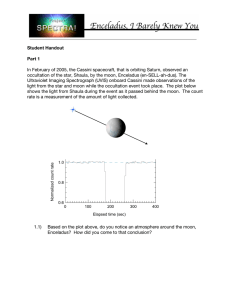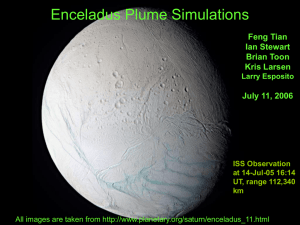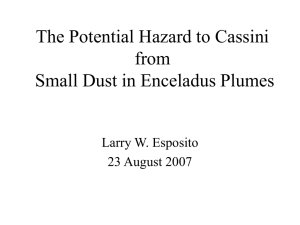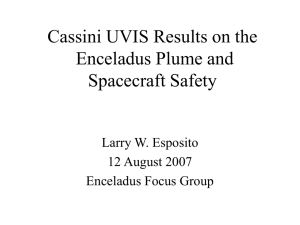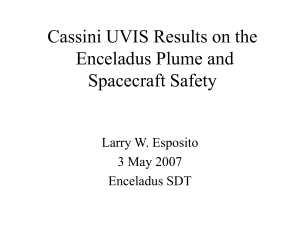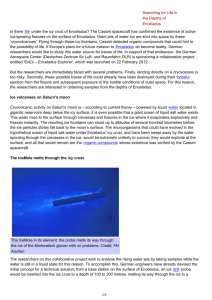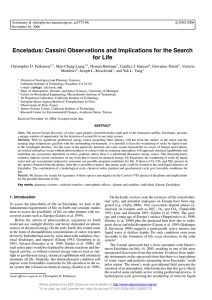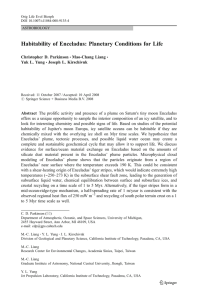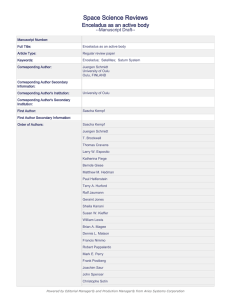Enceladus: Cassini Observations and Implications for the Search for Life
advertisement
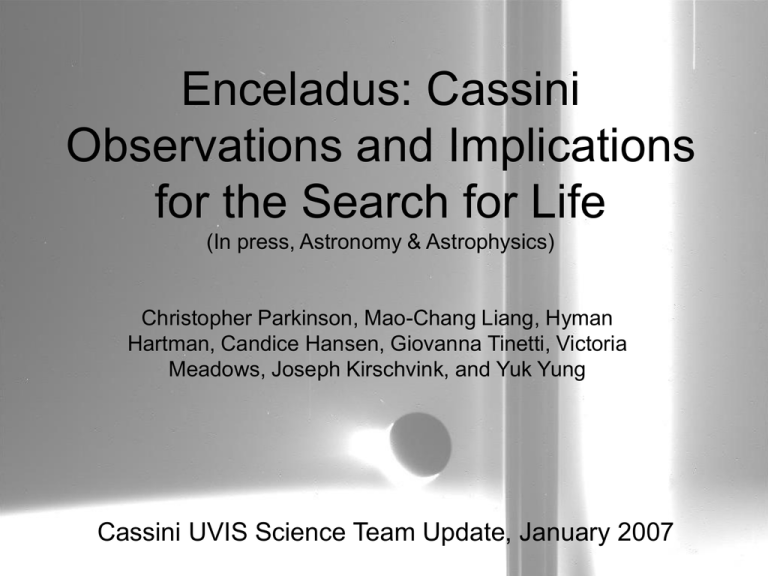
Enceladus: Cassini Observations and Implications for the Search for Life (In press, Astronomy & Astrophysics) Christopher Parkinson, Mao-Chang Liang, Hyman Hartman, Candice Hansen, Giovanna Tinetti, Victoria Meadows, Joseph Kirschvink, and Yuk Yung Cassini UVIS Science Team Update, January 2007 Context • Previous efforts to detect evidence for life elsewhere in the solar system have been focused on Mars and Europa • On July 14, 2005, the Cassini spacescraft had a close encounter with the Saturnian moon, Enceladus, resulting in one of the most unexpected discoveries from the Cassini mission Evidence • Multiple instruments on Cassini spacecraft show a large water vapour plume (Dougherty et al. 2006) eminating from Enceladus’ south polar region Radius (km) Gravity (cm s-2) Geometric albedo 250 11.5 0.99 (visual wavelengths) Escape velocity (m s-1) Thermal velocity (m s-1) Scale height of jet (km) 240 460 (H2O at 180 K) 80 UVIS INMS VIMS CIRS • The weak gravitational field prevents retention of an atmosphere, indicating the gas is likely resulting from some currently active geothermal venting process • A hydrological cycle governing the weathering of rocks by liquid water + any other concomitant radioactive emissions + other geothermal energy sources are possible incipient conditions for life Cassini Data and Analysis • The Cassini UltraViolet Imaging Spectrograph (UVIS) observed the occultation of Bellatrix (γ-Orionis) as it passed behind Enceladus as seen from the spacecraft (Hansen et al. 2006) • Analysis of UVIS spectra for the presence of other molecules done by method of leastsquares linear regression method (Bevington & Robinson 1992) • The residual is obtained by subtracting the H2O signal (Hansen et al. 2006) from the UVIS spectra • We then apply the linear regression to estimate upper limits for several molecules of astrobiological interest using normalized cross sections • Our calculated values for the upper limit of the column density for several species are consistent with detections from other instruments aboard Cassini spacecraft Species Abundance Reference CO2 0.032 a N2 0.040 a,b CH4 0.016 a C2H2 ~0.01 a C3H8 ~0.01 a NH3 <0.005 a CO <0.01 b, c SO2 <0.15 c dust 0.1 m-3 d electron ~100 cm-3 e N+ 3% of total ion f Organics Detected in ice g CO2 Detected in ice g a. Waite et al. 2006 (INMS); b. Hansen et al. 2006 (UVIS); c. Parkinson et al. 2006; d. Spahn et al. 2006; e. Tokar et al. 2006; f. Bouhram et al. 2006; g. Brown et al. 2006 (VIMS) Organics The main sources of organics are believed to be either from 1. extraterrestrial influx (i.e. comets - nucleus and interplanetary dust, macro- and micrometerorites) 2. synthesis of organic matter from inorganic molecules in the vicinity of submarine hydrothermal vents, as well as in shallow basins (Brack 1998; Raulin 2005) • Organic products can be obtained from submitting gas mixtures of various starting composition to electron or photon irradiation • Only reducing mixtures such as CH4-NH3-H2H2O or CO-N2-O2 allow the production of organic molecules (Raulin 2005) • The primitive atmosphere of the Earth was probably not the starting point of the prebiotic organic processes, since its main compostion (CO2-N2-H2O) was not favorable to the formation of organics From Becker and Epstein (1982) organic matter in carbonaceous chondrites can be separated into three fractions 1. fraction insoluble in both methanol and chloroform 2. fraction soluble in chloroform and 3. fraction soluble in methanol • Hartman et al. (1993) interpreted 1. the first insoluble component to be of interstellar origin and 2. the other two soluble fractions to have been synthesized on a hydrothermally altered planetoid body • The simultaneous synthesis of iron-rich clays with the polar organics may be indicative of events related to the origin of life on Earth Hydrological Cycle • Icy particles ~1 μm icy are emanating from Enceladus’ plume (Porco et al.,2006). • We use this value guiding our modeling effort with CARMA (Toon et al. 1988) to simulate the growth of water ice in the plume of Enceladus. • Start with 0.1 μm sized condensation nuclei with an abundance of 10-3 particles cm-3 • The reaction temperature is fixed at 170 K, 190 K, 210 K, and 225 K during the course of simulation, with a water vapor abundance of xx ×101x molecules cm-3 • In order to grow 1 μm size particles a reaction time of ~10 seconds is required (coagulation unimportant). • Our models infer that the formation and growth of ice particles takes place in the regions where the temperature has to be at least ~200 K. • Once the 1 μm sized particles particles from Enceladus’ plume land back on the surface of the moon, they must rapidly grow to 30 μm. • A microphysical description of sintering (Colbeck,1998) can only enhance the particle radius by ~1.1, implying sintering is not the contolling process for grain growth. • Thermally-activated normal grain growth could yield particle sizes ~30 μm in ~2 x 107 years where T ~ 145K, comparable to the estimated temperature in the center of the tiger stripes (Spencer et al., 2006). • However, these large grains are observed in the flanks of the tiger stripes , where temperatures may be as low as 70K (Spencer et al., 2006). • Therefore, we conclude the ice grains either 1. formed in the center of the tiger stripes and were moved outwards due to a mid-ocean-ridge-type spreading mechanism (Stempel et al., 2005), 2. or that a non-thermally controlled process (perhaps vapor diffusion) causes the ice grains to grow rapidly. Silicates: Exogenic or Endogenic? • Silicate material required for nucleation of the icy particles in the plume could come from the interior of the moon or from micrometeorites. • Cassini’s Cosmic Dust Analyzer (CDA) estimates dust influx ~0.2 kg s-1. • Both Porco et al (2006) and Hansen et al (2006) estimate material from the plume to be escaping at a rate of ~150 kg s-1. • ~1% dust fraction in plume (Kempf, private communication) obtains ~0.15 kg s-1 escaping dust. • Assumed micrometeroid flux of ~10-16 g/cm2s (Moses et al.,2000) gives an influx of dust of ~0.2 g/s over the south polar region. • Comparison with the Cassini’s CDA observation shows that the total influx of dust from exogenic sources is insufficient. • Clearly the vast majority of silicate material in plume must be endogenic, viz., coming from under the ice mantle. Origin of Nitrogen: where is the ammonia? • Impacting energetic ions will destroy any surface ammonia present, as the resurfacing rate isn't enough to shield them from destruction. There are radiogenic sources as well. (Loeffler et al., 2006). • Possible existence of NH3 in early moon history, but recycling of the ice mantle would "scrub" the ammonia out leaving mainly N2 • Over 1 billion years, at a recycling rate of 1 200 million years, obtains 5 -1000 cycles. • Cycling also results in an estimated ice mantle mass loss of ~20% (Kargel 2006). • The N2 (along with H2O2) could be subducted over time down to the clay/rock/ice/water interface. • Current estimates (Hansen et al., 2006; Waite et al., 2006; Parkinson et al., 2006) put N2 in the plume at about 4%. • 4% NH3 by mass can be delivered to the proto-saturnian disk by NH3 clathrated planetesimals from the cold outer regions of the disk (Rs >80). • Assuming the ice mantle had a similar value at formation, this suggests an ≥50% N2 depletion over 4 billion years due to the hydrological cycle of Enceladus. • What about the northern region? Perhaps there are ammonia reservoirs deep in the ice. • However, if the ice crust "moves around" at all, this may provide additional sources of ammonia, and hence, N2. • Additionally, acetylene, propane from methane by high temperature processes have been observed by the Cassini spacecraft. • Such high temperatures have been proposed by Matson et al (2006) but it is not at all clear at this point that this is indeed the case. • The processes governing the hydrological cycle apply to all species, with methane being a lot more stable than ammonia. • Therefore some methane may survive, where ammonia seems not to have done so. • Consistent with the Cassini observations, viz., H2O ~ 91%, N2 ~ 4%, CO2 ~ 3%, CH4 ~1.6%, ammonia < 0.5% (cf. Hansen et al., 2006, Waite et al., 2006 and Parkinson et al., 2006). Oxidants • The most abundant oxidant on icy satellites is most likely H2O2, which has been detected on Europa • we assume that the ratio of the H2O2 production rate and the H2O sputtering rate is the same for Europa and Enceladus • This implies that the production rate of H2O2 at Enceladus would be of the same magnitude as that on Europa ~ 1011 molecules cm−2 s−1 • NOTE: Baragiola (private communication) suggests this value may be one or two orders of magnitude too high • Following Chyba & Phillips (2001) for Europa, it is possible to estimate the total number cells that could exist in an ecosystem underneath Enceladus’ ice crust in the vicinity of the plume vent • Using estimated value of ∼150 kg/s for the ice resurfacing rate at the south pole of Enceladus suggests a crust turn-over time of ∼106 yr for an ice thickness of 1 km • Assume the conditions (such as the concentrations of H2O2 and HCHO, and a recycling ice thickness of 1.3 m) of Enceladus are similar to those of Europa • We estimate the microbial ecology in the region of Enceladus’ plume to be ∼1020 -1021 cells (for a 103 yr biological turn-over time) • Our estimated value is an order of magnitude greater per unit area than that for Europa. Conclusions • Presently Enceladus is the most exciting object in the solar system for the search of extant life • We have compelling evidence supporting the view that Enceladus has active hydrological, chemical and geochemical cycles, which are essential ingredients for originating and sustaining life • To our knowledge, these conditions are not duplicated anywhere else in our solar system except our planet • Compared to Mars, Titan and Europa, Enceledus is the only other object in our solar system that appears to satisfy the conditions for originating life at present What’s next? Future ground based and space observations and future space missions are urgently needed to advance our understanding of Enceladus. 1. long-term observations to establish whether the plumes are transient or in steady-state 2. searching for molecules of astrobiological significance, such as NH3 3. searching for the presence of photopigments (e.g. chlorophyll) 4. identifying the presence of oxidants on the surface, such as H2O2 and O3 5. mapping the North-South gradient in surface properties to quantify the rate of impact erosion and resurfacing Laboratory studies are needed, 1. to identify the chemical species responsible for 3.4 μm absorption feature in the ice in the “tiger stripes” (Berstein et al. 2005), 2. to study the chemical evolution of organics in ice in the presence of energetic photons and particles, and 3. to quantify the rate of production of oxidants such as H2O2 and O3 for conditions appropriate for Enceladus. • Modeling studies are needed to link the observations and laboratory experiments to the evolution of the hydrological, chemical redox and geochemical cycles on Encaladus • Another Cassini flyby in the works (extended mission)!
